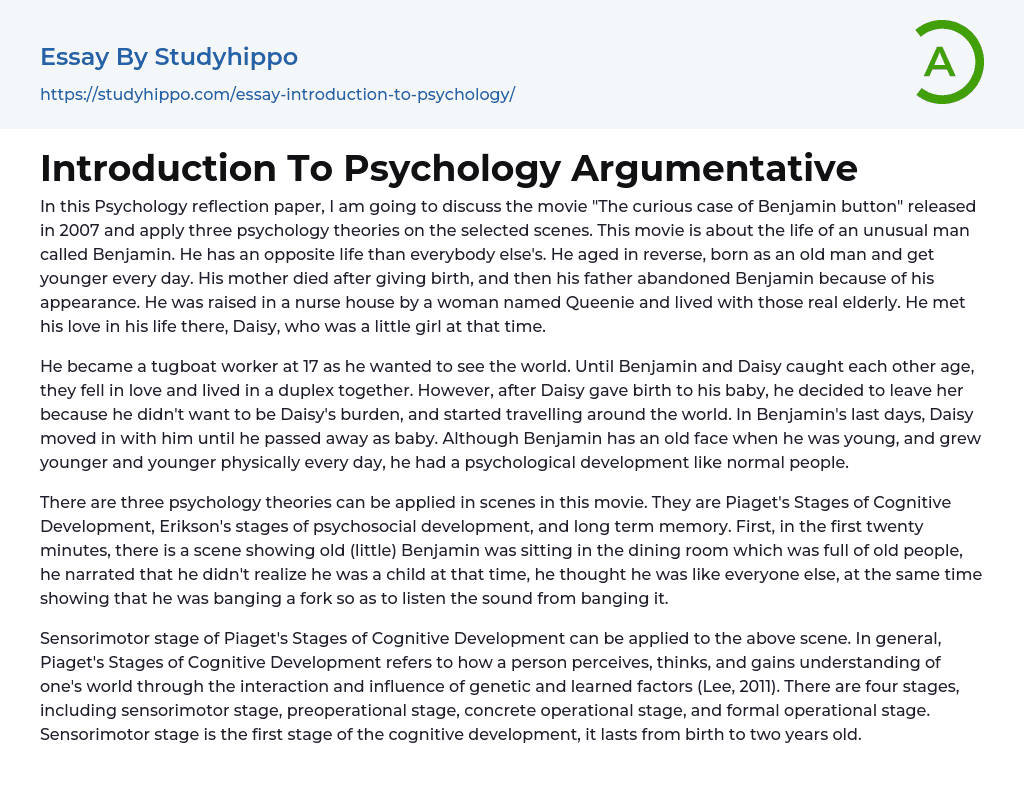In my reflective essay on Psychology, I intend to explore the 2007 movie "The curious case of Benjamin Button" employing three psychological theories to examine specific scenes. The film tells the intriguing story of a man named Benjamin who lives his life in reverse order relative to standard human aging. Born as an old man, he gradually gets younger each day. His birth resulted in his mother's death and due to his unusual appearance, his father abandoned him. He was brought up by a woman named Queenie in an elderly home where he first encountered Daisy - she would eventually be his lifelong love while she was still a young girl.
Beginning his career as a tugboat worker at just 17, he was propelled by the urge to traverse the globe. Both Benjamin and Daisy's paths crossed when they were of equal
...age, happily choosing to merge their lives in a shared duplex. Despite fathering children with Daisy, he decided to detach himself from her so that she would not be encumbered while he ventured on his global expeditions. Daisy remained by his side during his last moments until he slowly reverted back into innocence. Intriguingly, although Benjamin aged backward physically - looking older at first and gradually becoming younger - his mental growth took a standard course.
This film showcases the utilization of three distinct psychological theories throughout different scenes. These involve Piaget's cognitive development stages, Erikson's stages of psychosocial evolution, and the principle of long-term memory. For example, in a scene within the first 20 minutes of the movie, a young Benjamin is shown seated among elderly people in
a dining room. The narration reveals that he did not see himself as a child but rather considered himself equal to everyone else present. This scene is further amplified by his continuous act of striking a fork to listen to its sound.
The depicted situation can be examined using the sensorimotor phase from Piaget's Cognitive Development Stages. Essentially, these stages portray the procedure where an individual's comprehension, cognition, and perception of their surroundings are influenced by a combination of genetic and acquired factors (Lee, 2011). This theory includes four phases: the sensorimotor phase, the preoperational phase, the concrete operational phase, and the formal operational phase. The sensorimotor stage is considered as the first step in cognitive development which lasts from birth to two years old.
- Individual essays
- Infant essays
- Childhood essays
- Adolescence essays
- Growth Mindset essays
- Is Google Making Us Stupid essays
- Childhood Memory essays
- Abnormal Psychology essays
- Abraham Maslow essays
- Attachment Theory essays
- Authority essays
- Behaviorism essays
- Classical Conditioning essays
- Cognitive Psychology essays
- Counseling essays
- Developmental Psychology essays
- Educational Psychology essays
- Erik Erikson essays
- Family Therapy essays
- Jean Piaget essays
- Maslow's Hierarchy Of Needs essays
- Mental Health essays
- Operant Conditioning essays
- Personality Psychology essays
- Positive Psychology essays
- Psychoanalysis essays
- Psychotherapy essays
- Sigmund Freud essays
- Social Psychology essays
- Stanford Prison Experiment essays
- Supersize Me essays
- American Dream essays
- Barriers To Entry essays
- Capitalism essays
- Central Bank essays
- Compensation essays
- Consumerism essays
- Economic Development essays
- Economic Growth essays
- Economic Inequality essays
- Economic System essays
- Economy essays
- Employment essays
- Export essays
- Finance essays
- Free Trade essays
- Gross Domestic Product essays
- Human Development essays
- Income Inequality essays
- Industry essays




